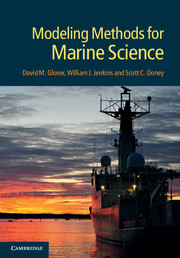Book contents
- Frontmatter
- Contents
- Preface
- 1 Resources, MATLAB primer, and introduction to linear algebra
- 2 Measurement theory, probability distributions, error propagation and analysis
- 3 Least squares and regression techniques, goodness of fit and tests, and nonlinear least squares techniques
- 4 Principal component and factor analysis
- 5 Sequence analysis I: uniform series, cross- and autocorrelation, and Fourier transforms
- 6 Sequence analysis II: optimal filtering and spectral analysis
- 7 Gridding, objective mapping, and kriging
- 8 Integration of ODEs and 0D (box) models
- 9 A model building tutorial
- 10 Model analysis and optimization
- 11 Advection–diffusion equations and turbulence
- 12 Finite difference techniques
- 13 Open ocean 1D advection–diffusion models
- 14 One-dimensional models in sedimentary systems
- 15 Upper ocean 1D seasonal models
- 16 Two-dimensional gyre models
- 17 Three-dimensional general circulation models (GCMs)
- 18 Inverse methods and assimilation techniques
- 19 Scientific visualization
- Appendix A Hints and tricks
- References
- Index
16 - Two-dimensional gyre models
Published online by Cambridge University Press: 05 June 2012
- Frontmatter
- Contents
- Preface
- 1 Resources, MATLAB primer, and introduction to linear algebra
- 2 Measurement theory, probability distributions, error propagation and analysis
- 3 Least squares and regression techniques, goodness of fit and tests, and nonlinear least squares techniques
- 4 Principal component and factor analysis
- 5 Sequence analysis I: uniform series, cross- and autocorrelation, and Fourier transforms
- 6 Sequence analysis II: optimal filtering and spectral analysis
- 7 Gridding, objective mapping, and kriging
- 8 Integration of ODEs and 0D (box) models
- 9 A model building tutorial
- 10 Model analysis and optimization
- 11 Advection–diffusion equations and turbulence
- 12 Finite difference techniques
- 13 Open ocean 1D advection–diffusion models
- 14 One-dimensional models in sedimentary systems
- 15 Upper ocean 1D seasonal models
- 16 Two-dimensional gyre models
- 17 Three-dimensional general circulation models (GCMs)
- 18 Inverse methods and assimilation techniques
- 19 Scientific visualization
- Appendix A Hints and tricks
- References
- Index
Summary
What is art but life upon the larger scale, the higher. When, graduating up in a spiral line of still expanding and ascending gyres, it pushes toward the intense significance of all things, hungry for the infinite?
Elizabeth Barrett BrowningOnward to the next dimension
Although one-dimensional models provide useful insight into basic biogeochemical processes, we are forced to admit that the world is made of more than one spatial dimension. The addition of an extra dimension to a model often does more than “fill space”, but rather imbues the model with behavior that is qualitatively different from its lower-dimensional analogue. The opportunity presented by the extra dimension is that more interesting, and perhaps more “realistic” phenomena may be modeled. This opportunity brings with it challenges, however, that are not just computational in nature. The choices of model geometry, circulation scheme, and boundary conditions become more complicated. Seemingly innocuous choices can have subtle or profound effects on how your model behaves. Moreover, matching model results to observations often requires decisions about whether features result from intrinsic processes of interest, or are mere artifacts of the choices made in model configuration.
For instructional purposes, we'll stick to a genre called gyre models which, as you might guess, are characterized by a quasi-circular flow on a plane. Such models have utility in the subtropics – at least that's where we'll be dwelling here – but can be used in many other parts of the ocean.
- Type
- Chapter
- Information
- Modeling Methods for Marine Science , pp. 409 - 452Publisher: Cambridge University PressPrint publication year: 2011



